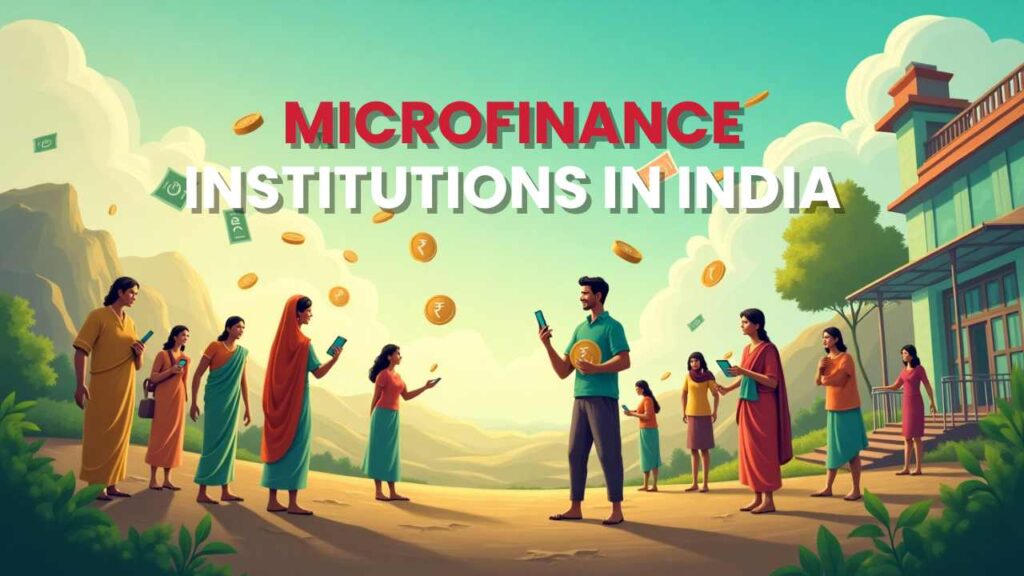The Microfinance Institutions have evolved to be very complex financial service providers whose institutions alone constitute financial inclusion in India. In 2025, Microfinance Institutions are reaching out to populations of millions of underbanked, especially women entrepreneurs and rural residents of the country and are offering them credit, savings and insurance and other much-needed financial services. The sector has experienced phenomenal growth with the microfinance portfolio getting to unprecedented heights, all the time holding onto the main agenda of empowering the economically deprived.
In today’s blog we will explore top Microfinance Institutions In India for 2025.
What Are Microfinance Institutions?
There are two key regulatory frameworks of Microfinance Institutions, which are Non-Banking Financial Company-Microfinance Institutions (NBFC-MFIs) and Small Finance Banks. The NBFC-MFI institutions are confined to small-ticket microloans to poor households, whereas the Small Finance Banks provide a deeper set of banking products, such as deposits, payments, and remittances, in addition to microfinance products.
Common Products Offered
Microfinance Institutions in India typically offer:
- Group Lending (JLG): The other is Joint Liability Group loans, whereby small groups of borrowers guarantee loans that are made to one another.
- Individual Microloans: Direct lending to individual borrowers for income-generating activities
- Micro-enterprise Credit: Larger loans for small business development and expansion
- Savings Products: Deposit accounts and recurring savings schemes
- Micro-insurance: Life, health, and asset protection insurance products
- Digital Payment Services: Mobile banking and digital transaction facilities
Regulatory Bodies
Reserve Bank of India (RBI) is the main regulator of Microfinance Institutions with directions on operation, capping of interest rates, and prudential norms. Self-regulation, advocacy, and best practice promotion among the Indian Microfinance Institutions through a medium of industry associations such as MFIN (Microfinance Institutions Network) and Sa-Dhan are important activities of these organizations.
What to Look for in an MFI in 2025
The following are some of the important aspects to take note of when choosing among the many Microfinance Institutions in India:
- Digital Integration: The new-age MFIs use technology to hasten the speed of loan processing, electronic payments and customer service
- Transparent Pricing: Clarity in disclosure of rates of interest, processing fees and repayment terms, free of any form of hidden charges
- Geographic Reach: Presence of an extensive chain of branches, and capturing of your area of operation in terms of service delivery
- Product Diversity: Financial services, which go beyond basic lending, include savings, insurance and a complete set of services.
- Regulatory Compliance: Excellent compliance with RBI guidelines and best practices of the industry regarding customer protection
Top 10 Microfinance Institutions in India 2025
1. Bandhan Financial Services / Bandhan Bank

Bandhan Bank is one of the most famous stories of transformation of Microfinance Institutions, as it originally started as a microfinance company and then grew to serve as a commercial bank. They started Bandhan in 2001, and ever since then, they have only focused on financial inclusion, but have increased their services. Its network has a strong presence in rural India, going deep into villages and the institution relies on women as borrowers with its group lending model. Bandhan has a distinct method of integrating conventional microfinance concepts with the advantage of modern banking facilities and thus makes it the number one Microfinance Institution in India. It has managed to ensure sustainable growth in the competitive microfinance sector by ensuring that it has been able to maintaining its asset quality, despite its expansion in its operations.
- Services Offered: Savings accounts, current accounts, fixed deposits, micro-loans, MSME loans, agricultural loans, home loans, two-wheeler loans, insurance products, payment services, and remittance facilities.
- Number of Borrowers & Reach: Serves over 2.4 crore customers across 22 states through 4,500+ branches
- Key Achievements: India’s fastest-growing bank with over ₹1 lakh crore in total business
Website: https://www.bandhanbank.com/
2. CreditAccess Grameen
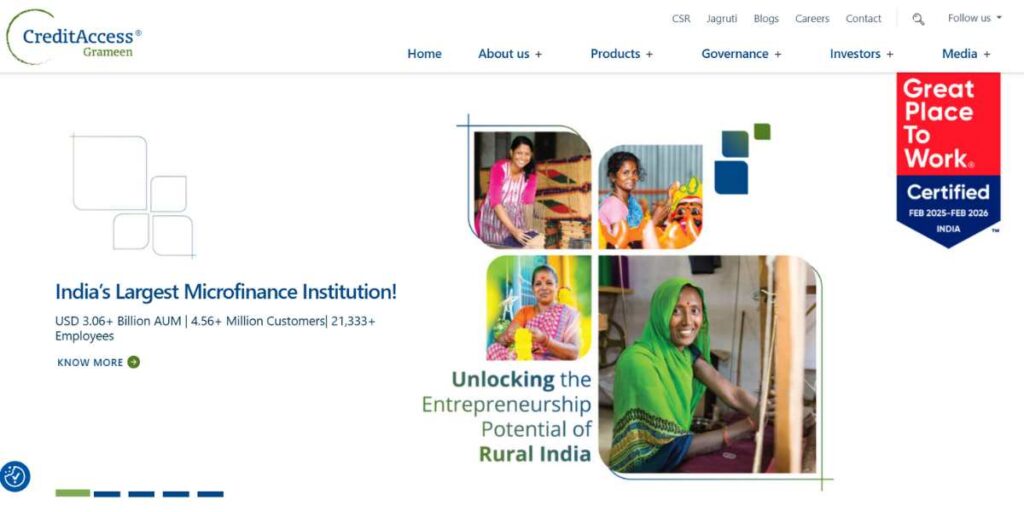
CreditAccess Grameen Limited is a huge microfinance company in India that serves 4.25 million female customers across India with its AUM of USD 2.6 billion+. The company is an NGO founded in 1999 in South Bengaluru as a Non-Banking Finance Company and an NBFC-MFI just like the rest of the MFIs is publicly listed and has made the gold standard of the Microfinance Institutions in India. CreditAccess Grameen majors more in rural and semi-urban markets offering women loans free of any collateral using its well-documented model of Joint Liability Group. The institution has entrenched a robust technology base which allows the institution to operate efficiently and monitor loan portfolios in real-time. The lender stated that 3 its loan portfolio increased to Rs 25,395 crore in February 2024 as compared to Rs 24,810 crore in December 2024 indicating healthy growth.
- Services Offered: Micro-loans through Joint Liability Groups, individual business loans, micro-enterprise loans, digital payment solutions, and financial literacy programs.
- Number of Borrowers & Reach: Over 4.25 million active borrowers across 19 states and union territories
- Key Achievements: India’s largest microfinance institution by assets under management and borrower base
Website: http://www.creditaccessgrameen.in
3. Janalakshmi Financial Services / Jana Small Finance Bank
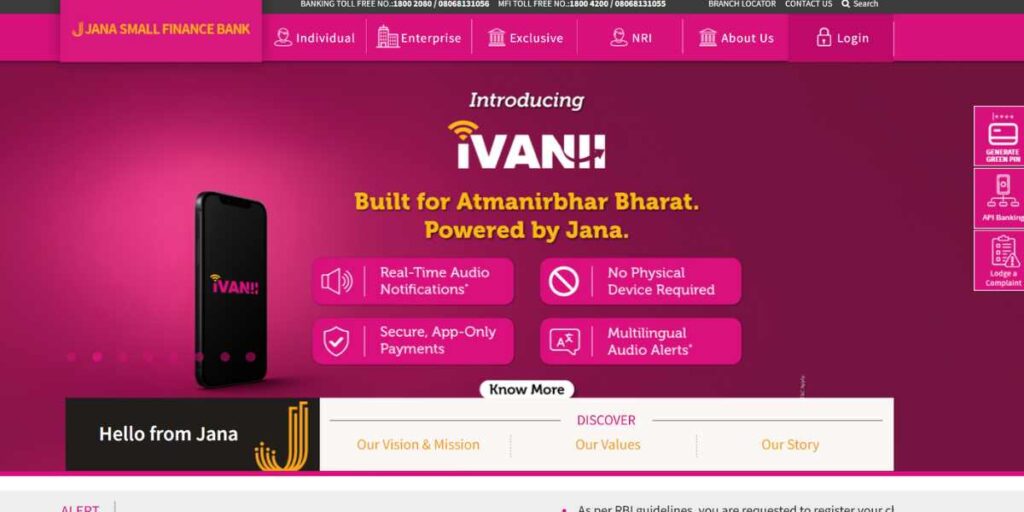
Jana Small Finance Bank is a by-product of the metamorphosis of Janalakshmi Financial Services and it is a shift toward full banking services by the Microfinance Institutions. The institution came into existence with a vision to serve underbanked people with innovative financial products and with technology-driven services. Jana has established a very strong presence in both urban and semi-urban markets with a refined presence in micro and small units and also in individual borrowers. Being one of the Small Finance Banks in India, Jana provides a full banking experience, even though it continues its microfinance tradition among Microfinance Institutions. The bank has been considered a major investor in digital infrastructure to deliver smooth customer experiences and effective service delivery.
- Services Offered: Savings and current accounts, fixed deposits, micro-loans, MSME loans, affordable housing loans, vehicle loans, gold loans, insurance products, and digital banking services.
- Number of Borrowers & Reach: Serves over 5.5 million customers through 700+ branches across India
- Key Achievements: Successful transition from NBFC-MFI to Small Finance Bank with strong digital adoption
Website: http://www.janabank.com
4. Equitas Small Finance Bank

Equitas Small Finance Bank is one of the financial institutions at the forefront of the Microfinance Institutions due to its innovativeness and effective transformation to become a holistic small finance bank enterprise. Based on the size of assets under management, the wide loan portfolio and its outreach, Equitas Small Finance Bank can be termed as one of the best microfinance companies in India. It has also developed a reputation for offering micro and small businesses, individual clients and rural citizens with specialized financial services. Equitas has come up with original products that fulfil the needs of the target market in the most direct manner and at the same time uphold stringent risk management frameworks. The customer-centric nature and financial inclusion have resulted in one of the Microfinance Institutions in India giving preference to the bank.
- Services Offered: Savings accounts, current accounts, fixed deposits, recurring deposits, micro-loans, vehicle loans, home loans, business loans, two-wheeler loans, and insurance products.
- Number of Borrowers & Reach: Over 1.6 million active borrowers served through 850+ branches
- Key Achievements: Strong asset quality with diversified loan portfolio and consistent profitability
Website: http://www.equitasbank.com
5. Spandana Sphoorty Financial
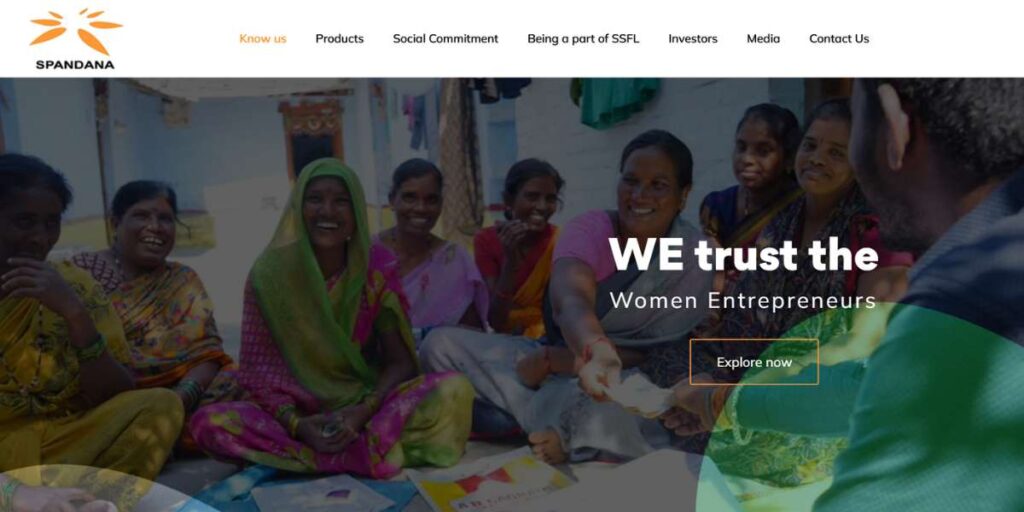
Spandana Sphoorty Financial Limited is a leading Microfinance Institution in India and it has a profound emphasis on its rural and semi-urban markets. Established in 1998, the firm has created a widely branching network to cater largely to women borrowers using the group lending system. Spandana has focused its expertise in the realm of agricultural and rural financing, endeavouring to fulfil the needs of farming communities and rural entrepreneurs and it has become the most competent Microfinance Institution of India to do so. The institution has survived through different cycles of the market and changes in regulations which have proved resilient and able to adjust. Spandana has been successful in attaining the trust of financial inclusion programs by being committed to its overall principle of being a responsible lender that considers the welfare of its customers.
- Services Offered: Joint Liability Group loans, individual business loans, agricultural loans, livestock loans, and rural livelihood financing programs.
- Number of Borrowers & Reach: Approximately 3.4 million active borrowers across 16 states
- Key Achievements: One of the oldest and most experienced microfinance institutions with strong rural penetration
Website: http://www.spandanasphoorty.com
6. Satin Creditcare Network Limited (SCNL)

Satin Creditcare Network Limited is an Indian company that belongs to the new wave of Microfinance Institutions, which integrates modern technologies with traditional beliefs of microfinance ideology and professional management concepts in Microfinance Institutions. SCNL has been in existence since 1990 and has evolved into an inclusive platform that caters to various customer segments with a variety of products. The key aspects in which the company has set up its presence are in the urban and rural markets, especially serving women entrepreneurs and micro-enterprises. The risk management and customer service strategy by SCNL has always acted as a yardstick in the Microfinance Institutions of India. The organization has also heavily invested in putting in place solid systems and processes capable of supporting scalable and sustainable operations.
- Services Offered: Micro-loans, MSME loans, individual business loans, two-wheeler loans, consumer durable loans, and digital financial services.
- Number of Borrowers & Reach: Over 1.8 million active customers served across 20 states
- Key Achievements: Strong technology platform with diversified product portfolio and consistent growth
Website: http://www.satincreditcare.com
7. Arohan Financial Services

Arohan Financial Services has distinguished itself among Indian MicroFinance Institutions with its thrust on women empowerment and rural development. Arohan was founded on the idea of being customer-focused and offering new service delivery models in 2006 and in a short time it has developed a good reputation for taking this rather than being profit-driven. The institution operates mainly in eastern and northeastern India which have mostly not been covered by formal financial institutions. The local market and cultural sensitivity have also allowed Arohan to establish quality tie-ups with the rural communities owing to their thorough knowledge of these as well as the influence that it has gained over them. Arohan is unique among other Microfinance Institutions in India in that it is ready to measure its social impact as well as report on its development progress.
- Services Offered: Group loans, individual microloans, agricultural loans, skill development programs, and financial literacy initiatives.
- Number of Borrowers & Reach: Approximately 1.5 million borrowers served across 17 states
- Key Achievements: Strong focus on women’s empowerment with over 99% female borrowers
Website: http://www.arohan.in
8. ESAF Small Finance Bank
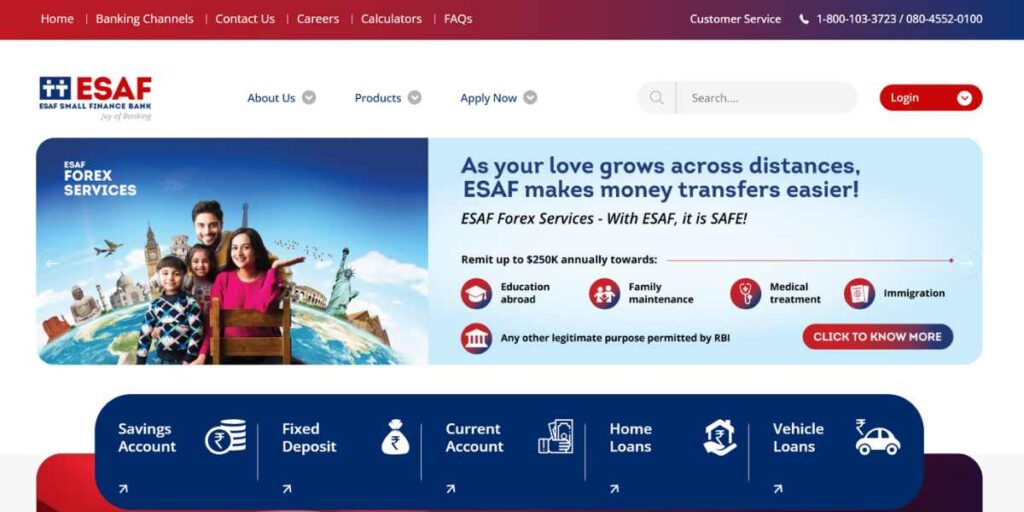
ESAF Microfinance is one of the major Microfinance Institutions which has benefitted over 4 lakh members with the accomplishment of 150 branches. The conversion of microfinance institutions into full-service small finance banks has seen ESAF Small Finance Bank rise and become one of the major players in the sector of Microfinance Institutions sector in India. The institution has established itself as a solid presence in South India especially with specific strengths of serving communities of agriculture and rural entrepreneurship. This aspect of ESAF is unlike other Microfinance Institutions since the former integrates financial services with social development programs. The bank has been investing a lot of money in both technology and human resources so that it might provide quality services to its largely rural customers.
- Services Offered: Savings accounts, fixed deposits, micro-loans, agricultural loans, MSME loans, gold loans, insurance products, and remittance services.
- Number of Borrowers & Reach: Over 4 lakh active customers served through a network of branches across southern India
- Key Achievements: Successful transformation to Small Finance Bank with strong rural focus
Website: http://www.esafbank.com
9. Fusion Microfinance

Fusion Microfinance has managed to become a trusted institution of the Microfinance Institutions because it focuses on the northern and central markets in India. Customer relationships and efficient service delivery mechanisms have been the pillars that the company has put in place in building its reputation. Fusion has come up with specific products aimed at reaching its various customer segments such as women entrepreneurs, small traders, and micro-enterprises. This has seen it through in terms of risk management and portfolio quality at the institution keeping it stable in terms of operation amid different market situations. Fusion is known to have responsible lending practices and customer protection measures among the other Microfinance Institutions that exist in India.
- Services Offered: Joint Liability Group loans, individual microloans, business loans, and livelihood financing programs.
- Number of Borrowers & Reach: Approximately 1.2 million active borrowers across 15 states
- Key Achievements: Strong presence in northern India with consistent asset quality maintenance
Website: https://fusionfin.com/
10. Svatantra Microfin
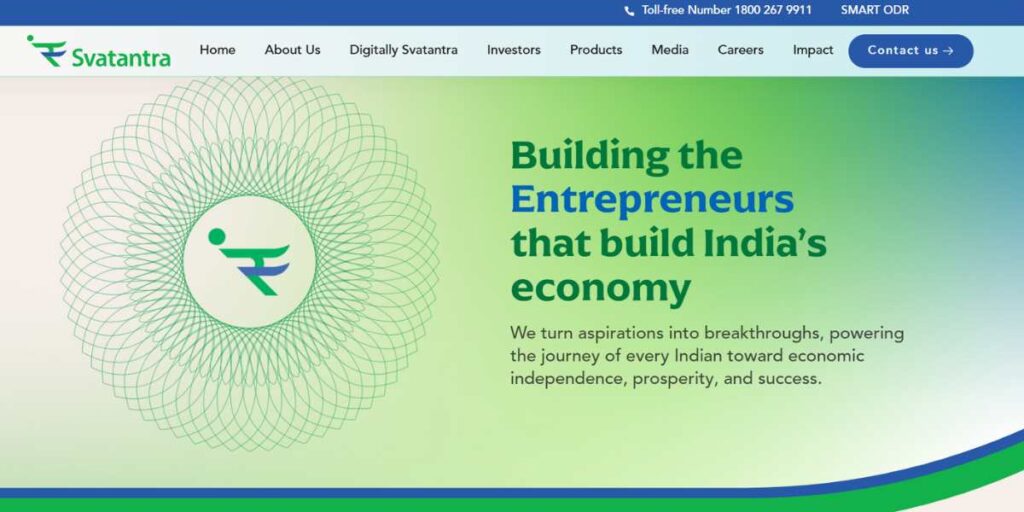
The Svatantra Microfin completes our list of top Microfinance Institutions as it has a narrowly defined focus serving rural and semi-urban markets in central and northern India. The institution has reinforced a creamy operational framework by selecting the right market as well as immersing itself in the community. The business model adopted by Svatantra focuses on sustainable growth and long-lasting relationships with the customer rather than on short-term growth. The firm has gained experience in lending to farm communities and to rural candidates because they need adaptable loan products. Svatantra is a Microfinance Institution in India which is quite conservative in its lending policies and has a heavy focus on customer education and is conscious of customer financial literacy.
- Services Offered: Group lending products, individual educational microloans, agricultural financing, and rural development programs.
- Number of Borrowers & Reach: Over 800,000 active borrowers served across central and northern Indian states
- Key Achievements: Strong focus on rural markets with a sustainable growth model
Website: http://www.svatantramicrofin.com
Comparison Table: Microfinance Institutions in India at a Glance
| Institution | Type | Primary Market | Active Borrowers | Key Strength |
| Bandhan Bank | Small Finance Bank | Pan-India | 2.4 crore | Largest customer base |
| CreditAccess Grameen | NBFC-MFI | Pan-India | 4.25 million | Highest AUM |
| Jana Small Finance Bank | Small Finance Bank | Urban/Semi-urban | 5.5 million | Digital innovation |
| Equitas Small Finance Bank | Small Finance Bank | Pan-India | 1.6 million | Diversified portfolio |
| Spandana Sphoorty | NBFC-MFI | Rural/Semi-urban | 3.4 million | Rural expertise |
| Satin Creditcare | NBFC-MFI | Pan-India | 1.8 million | Technology platform |
| Arohan Financial | NBFC-MFI | Eastern India | 1.5 million | Women empowerment |
| ESAF Small Finance Bank | Small Finance Bank | Southern India | 400,000 | Agricultural focus |
| Fusion Microfinance | NBFC-MFI | Northern India | 1.2 million | Regional expertise |
| Svatantra Microfin | NBFC-MFI | Central/Northern | 800,000 | Conservative approach |
Growth Drivers & Outlook for 2025
Several significant factors give credence to the growth trend of the Microfinance Institutions in 2025:
- Digital Transformation: The use of technology allows the Microfinance Institutions in India to cut their operational expenses and enhance customer experience
- Financial Inclusion Push: In India, the availability of the addressable market to Microfinance Institutions keeps on increasing with the governmental efforts as well as the regulatory support
- Rural Economic Growth: Rising agriculture earnings and economic activity create the demand for financial services of Microfinance Institutions
- Product Innovation: Innovation in the creation of new financial products aimed at particular customer groups strengthens the value proposition of Microfinance Institutions
- Regulatory Clarity: The operational certainty on the long-term growth strategies of Microfinance Institutions has clear guidelines concerning with RBI
Sector Challenges & Mitigation Tactics
Nevertheless, there are several challenges which are posed to Microfinance Institutions:
- Over-indebtedness Concerns: Customer multiple borrowing dictates the need to employ better credit information sharing and a responsible lending attitude amongst the Microfinance Institutions
- Interest Rate Pressures: Price regulation through caps reduces the operating profitability of the Microfinance Institutions requiring improvements in operational efficiency.
- Competition Intensity: To ward off the emerging competition, the existence of fintech companies and traditional banks necessitates that Microfinance Institutions distinguish their services.
- Asset Quality Management: The volatility in economics has implications for repayment capacity and this necessitates strong risk management mechanisms at Microfinance Institutions
- Regulatory Compliance: Such progressive regulations necessitate an ongoing investment on the part of the Microfinance Institutions in compliance infrastructure.
Use Cases: Who Should Choose MFIs?
The population segmented into different customer groups in India and endorsed by Microfinance Institutions in India has particular financial demands:
- Women Entrepreneurs: The group lending model and the supportive ecosystems enable the Microfinance banks in India to start a small business.
- Rural Farmers: Farming activities and crop cycles are financed in India by agricultural loans and seasonal financing products of the Microfinance Institutions
- Micro-Enterprises: In India, Microfinance Institutions provide owners of small businesses with collateral-free loans and business development services
- Unbanked Populations: It is the poor communities that cannot access conventional banking services that MFI in India offers access to formal services
- Urban Poor: Informal settlements in cities use finance available through Microfinance Institutions to save and borrow funds affordably
Conclusion
The Indian Microfinance Institutional landscape in 2025 depicts a developed mobility with things being managed by the technology sector, which remains of great importance in financial coverage. These 10 best Microfinance Institutions in India reflect a wide range of ways and means to reach out to the underbanked population and ensure the viability of business models. With the entry into India of a new microfinance institution and the adoption of digital transformation strategies by the existing ones and the enlargement of the bank products, the new organizations face the major issue of sticking to the primary mission of upliftment of the economically deprived communities. This dynamic of the Industry in India where basic lending has changed to wide-ranging financial services provisions is an indication of the flexibility and robustness of Microfinance Institutions to accommodate customer demands and regulatory standards.
FAQs
1. What are the differences between NBFC-MFIs and Small Finance Banks in the context of Microfinance Institutions?
NBFC-MFIs deal with only microfinance-related services and do not have the ability to accept a deposit whereas Small Finance Banks are allowed to offer all varieties of banking services such as savings, fixed deposits, payment services and much more. The two varieties of Microfinance Institutions deal with the same population of customers yet on various regulatory schemes and operational capacities.
2. What are the mechanisms of interest rate establishment of Lois by the Microfinance Institutions in India?
Interest rates within the Microfinance Institutions within India are pegged by elements such as cost of funds, operational costs, risk pricing and regulatory measures of the RBI. RBI has set up pricing guidelines, whereby Microfinance Institutions need to be transparent in their pricing system and the rates also need to be reasonable.
3. Which documents are necessary to take a loan with Microfinance Institutions?
In India, most of the Microfinance institutions usually demand simple identity proof (Aadhaar card), address verification, income (individual loans only), and photos. In the case of group loans, little documentation will be required since the joint liability model necessitates that the group of loans have limited documentation requirements. Microfinance Institutions in India are available easily to customers due to the simplified documentation process without a bunch of paperwork.
4. What are the effects of technology on the workings of Across India?
Technology has transformed the way of Microfinance Institutions with digital processing of loans, mobile banking, automated evaluation of risks, and real-time observation of the portfolio. In India, the availability of mobile apps (for loan applications, repayments, and account management) in many Microfinance Institutions is making the operations of these units and the convenience of customers much easier.
5. What must customers think about when selecting between various Microfinance Institutions?
The main points that should be considered by the customers are interest rates, processing fees, flexibility in terms of repayments, quality customer service, availability of branches, and other services provided. Another aspect that should be checked is whether the selected institution is duly regulated by the RBI and engages in the practice of Responsible Lending ensuring safeguarding and equity to lenders by Microfinance Institutions.
